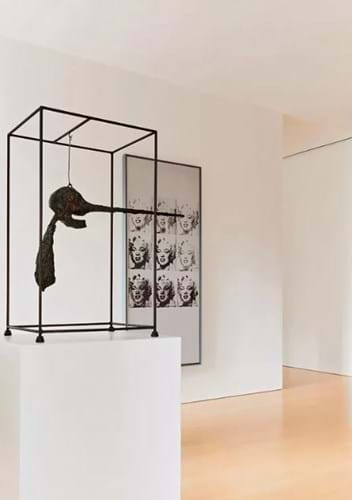
Among a collection from divorcees Harry and Linda Macklowe that sold at Sotheby's were Alberto Giacometti’s 'Le Nez' (a version conceived in 1949 and cast c.1964) and Andy Warhol’s 'Nine Marilyns', 1962. Image: Sotheby's.
The completion of the sale of Linda and Harry Macklowe’s renowned art collection for over $900m following their divorce made headlines around the world last month.
In their case, the judge in the State of New York ordered the sale of their art – but what happens to art collections on divorce under English law?
When spouses separate, the first step is to identify and value their assets, and to quantify their needs, eg for a home and an income stream (as assessed by the court in light of the assets available and the lifestyle during the marriage).
If the parties’ assets are less than their needs, then the assets will be distributed so as to meet the parties’ needs to the extent possible, prioritising any children. The source of the assets will be of limited relevance.
Where assets exceed needs – as is likely to be the case for those with extensive art collections – the next stage is to characterise each asset as ‘matrimonial’ or ‘non-matrimonial’.
Matrimonial assets are those built up by the parties during their marriage, whereas non-matrimonial assets derive from a source external to the marriage, eg pre-owned or inherited assets.
For example, a portrait of a family ancestor inherited during the marriage will be a non-matrimonial asset, whereas a sculpture purchased using income earned during the marriage will be matrimonial.
Following the categorisation of assets, the basic assumption is that matrimonial assets are shared equally, and non-matrimonial assets are retained by the owner.
However, non-matrimonial assets can be transferred to the financially weaker party, if this is necessary to ensure both parties will be able to meet their financial needs, or to comply with a nuptial agreement.
So if, for example, the portrait of an ancestor is worth £2m, and without it being sold there would be insufficient funds for both parties to purchase a suitable home, the court may order its sale and the distribution of the proceeds between the parties despite the fact it is a non-matrimonial asset.
Where an art collection is a matrimonial asset and is to be shared, difficulties may arise over implementation. The collection could be shared such that each party receives items with a broadly equal total value.
However, if there is a dispute as to who should keep a particular item, this will need to be resolved by the judge, who may look at matters such as who chose it, or has the closest emotional connection to it.
Valuation disputes
In practice, sharing items in specie* in this way can be difficult if there are valuation disputes.
The valuation given by experts in the Macklowe case differed by hundreds of millions of dollars.
In circumstances where there are significant discrepancies in expert valuations the only way to determine and share a collection’s value is for it to be sold and the proceeds distributed.
This can lead to rather unfortunate outcomes for passionate art collectors/artists to whom, very often, the integrity of a collection is paramount, or who are particularly attached to certain art works.
The distinction between non-matrimonial and matrimonial assets, in practice, can be less clear-cut than the parties assume; what happens to a collection a spouse began before marriage but which amassed most of its bulk (and value) over the following decades? Can an artist’s own works be ringfenced and should royalties, including profits from any re-sale rights, be included? Cases often turn on their own facts and require careful analysis.
Further challenges are added where a spouse holds intellectual property rights in art works or, in the case of crypto assets/NFTs, rights in an underlying, physical art work, which has considerable monetary value.
Carefully drafted pre-nuptial agreements can demonstrate the parties’ intention in anticipation of marriage and details about one’s collection, and help to avoid these kind of disputes in the event of divorce.
* ATG note: The delivery of a financial asset in its current form rather than in an equivalent amount of cash.
Hunters Law is based in Lincoln’s Inn, 9 New Square, London.












